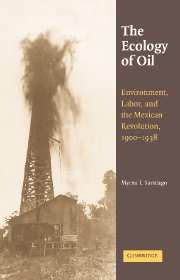Book contents
- Frontmatter
- Dedication
- Contents
- List of Maps, Figures, Tables, and Appendices
- Acknowledgments
- Introduction
- PART ONE THE HUASTECA BEFORE OIL
- PART TWO THE ECOLOGY OF OIL
- 2 Controlling the Tropical Forest: The Shift in Land Tenure Patterns
- 3 The Anatomy of Progress: Changing Land Use Patterns
- 4 “Masters of Men, Masters of Nature”: Social Change in the Huasteca
- PART THREE CHALLENGING THE ECOLOGY OF OIL
- Conclusion
- Epilogue
- Appendices
- A Note on the Sources
- Archives Consulted
- Selected Bibliography
- Index
3 - The Anatomy of Progress: Changing Land Use Patterns
from PART TWO - THE ECOLOGY OF OIL
Published online by Cambridge University Press: 05 March 2015
- Frontmatter
- Dedication
- Contents
- List of Maps, Figures, Tables, and Appendices
- Acknowledgments
- Introduction
- PART ONE THE HUASTECA BEFORE OIL
- PART TWO THE ECOLOGY OF OIL
- 2 Controlling the Tropical Forest: The Shift in Land Tenure Patterns
- 3 The Anatomy of Progress: Changing Land Use Patterns
- 4 “Masters of Men, Masters of Nature”: Social Change in the Huasteca
- PART THREE CHALLENGING THE ECOLOGY OF OIL
- Conclusion
- Epilogue
- Appendices
- A Note on the Sources
- Archives Consulted
- Selected Bibliography
- Index
Summary
The landscape is too vast, too glorious, to be defaced by these slight tokens of human handiwork, and their presence brings up, besides the idea of the sublimity of nature, another great thought, for they speak eloquently of the power of the mind of man and the strength of his hand when united to the performance of a great work.
Reau Campbell, 1890The beauty of nature vanishes, in the oil fields, once her wealth appears.
Marian Storm, 1924It took nature millions of years to evolve into rainforest, mangroves, swamps, and sand dunes in northern Veracruz. It took indigenous peoples of the Huasteca millennia to adapt to and coevolve with the environment nature created. It took American and British petroleum companies less than four decades to uproot the ecosystems of northern Veracruz and replace them with an industrial landscape. Huasteca Petroleum summarized the process thus:
Discovery and development of the known oil fields in Mexico were the achievement of British and American pioneers, who came into this region at a time when it was a little-known, pest-infested, tropical wilderness…In the face of almost insuperable obstacles, they made remarkably rapid progress. In less than 10 years Mexico had begun to attract world-wide attention as an oil producer. Development of the famous “Golden Lane,” one of the world's greatest known oil fields, discovered in 1910, placed Mexico in the first rank among oil-producing countries. The transformation was profound. Tampico, a sleepy little fishing port, became almost overnight a thriving city…In the oil fields, where formerly the tropical jungle supported only a few Indians, 50,000 oil field workers, largely Mexicans, found immediate, continuous employment.
Indeed, upon gaining control over nature through land and other deals, the foreign oil companies proceeded to reshape the anatomy of the Huasteca beyond recognition. Like plastic surgeons gone mad, the oil pioneers eliminated the mangroves, scarred the sand dunes, razed the rainforest, filled in the swamps, and degraded the rest of the environment as never before in the history of the Huasteca. Such was the result and definition of progress in the early twentieth century: a landscape of drastic man-induced metamorphosis, where men replaced ecosystems with industry and urbanization, where metal substituted for trees and grays and blacks replaced shades of green.
- Type
- Chapter
- Information
- The Ecology of OilEnvironment, Labor, and the Mexican Revolution, 1900–1938, pp. 101 - 147Publisher: Cambridge University PressPrint publication year: 2006



